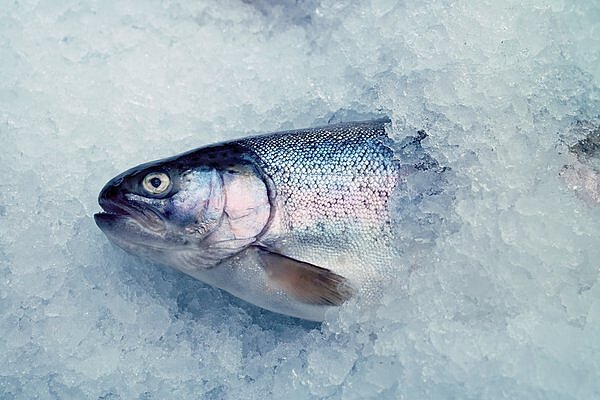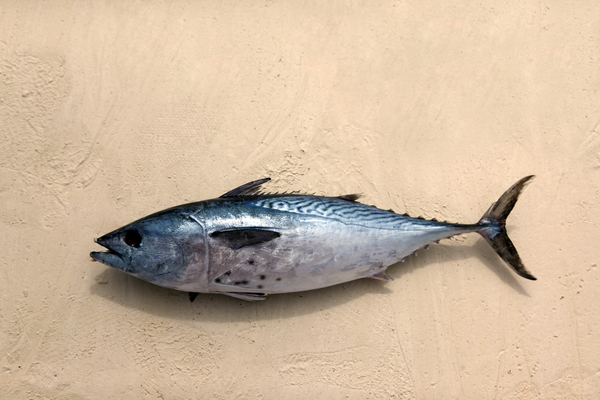Salmon

Salmon is a popular and healthy fish with many benefits for your dog's diet. But how much salmon can your dog eat? And which type of salmon is best? In this article, you'll find out everything you need to know about salmon for dogs.
What is salmon?
Salmon are fish that live in cold waters and feed mainly on plankton, crustaceans and smaller fish. There are different types of salmon, for example Atlantic salmon, Pacific salmon or salmon trout. The pink to red flesh of salmon is rich in protein, vitamins and omega-3 fatty acids.
Why is salmon healthy for dogs?
Salmon is healthy for dogs because it contains many nutrients that are important for a dog's health. For example, salmon can
- Strengthen the immune system
- nourish the skin and coat
- protect the joints
- promote heart health
- improve brain function
- inhibit inflammation
Omega-3 fatty acids are essential for dogs, i.e. they cannot produce them themselves and must be taken in with food. Salmon is one of the best sources of omega-3 fatty acids, which are important for cell membranes, hormone production and blood clotting, among other things.
How much salmon can my dog eat?
How much salmon your dog can eat depends on various factors such as weight, age, activity and state of health. As a rule of thumb, salmon should not make up more than 10% of your dog's daily calorie requirement. This corresponds to about 30 grams of salmon per kilogram of body weight per week.
Which type of salmon is best for my dog?
Not all types of salmon are equally suitable for your dog. You should make sure that you only feed your dog fresh or frozen wild salmon from clean waters. Farmed salmon can be contaminated with antibiotics, hormones or heavy metals that can harm your dog. You should also avoid giving your dog smoked, salted or seasoned salmon, as these methods of preparation can contain too much salt, sugar or preservatives, which can cause gastrointestinal problems or kidney damage.
How can I prepare salmon for my dog?
You can feed your dog salmon raw or cooked, depending on what he prefers. If you feed your dog raw salmon, you should freeze it first to kill any parasites that could infect your dog. If you want to give your dog cooked salmon, you should only cook it briefly in water or broth without salt or spices so that the nutrients are retained. You can mix the salmon into your dog's normal food or give it as a treat between meals. You can also give your dog the salmon skin, which contains lots of nutrients and can be used as a chew.
What are the possible disadvantages or risks of salmon for dogs?
Salmon is generally well tolerated by dogs, but there are some possible disadvantages or risks that you should consider before feeding your dog salmon. These include
- Allergies: Some dogs may be allergic to salmon or other types of fish. Symptoms can include itching, rash, diarrhea, vomiting or breathing difficulties. When feeding your dog salmon for the first time, only feed small amounts and observe his reaction. If you notice signs of an allergy, you should consult a vet immediately.
- Parasites: Raw salmon can contain parasites such as tapeworms or Neorickettsia helminthoeca, which can make your dog sick. Tapeworms can cause weight loss, loss of appetite or intestinal obstruction. Neorickettsia helminthoeca can cause a fatal disease called salmon fever, which is characterized by fever, vomiting, diarrhea, lethargy or bleeding. To avoid the risk of parasite infestation, only frozen or cooked salmon should be fed.
- Overfeeding: Too much salmon can lead to an overdose of omega-3 fatty acids, which can result in bleeding disorders, liver problems or vitamin E deficiency. Vitamin E deficiency can lead to muscle weakness, nerve damage or eye problems. To avoid overfeeding, you should only feed the recommended amount of salmon and keep an eye on the calorie intake.
Salmon is a healthy and tasty fish with many benefits for your dog's diet. It can strengthen the immune system, nourish the skin and coat, protect the joints, promote heart health and improve brain function. You should only feed your dog fresh or frozen wild salmon from clean waters. You can feed your dog salmon raw or cooked, depending on what he prefers. However, you should pay attention to the quantity, preparation and possible disadvantages or risks of salmon for dogs.
If you notice any signs of hypersensitivity or poisoning in your dog, you should see your vet immediately. We are not a substitute for a vet, but we try to be as accurate as possible. Every dog reacts differently and we recommend you get a second opinion or consult your vet if in doubt.
Stay healthy and take good care of your four-legged friend!😊
Similar to Salmon
Trout has many benefits for your dog's health and well-being. Trout is rich in high-quality protein, which is important for muscle building and cell renewal. Trout is also rich in omega-3 fatty...
Mackerel has many benefits for dogs that can promote both physical and mental health. Here are some of them: Mackerel is a high-quality source of protein, which is important for muscle building,...
Halibut is a large flatfish known for its firm, white flesh and mild flavor. There are two main species: the Pacific halibut, found in the North Pacific, and the Atlantic halibut, which lives in the...
Tuna is a large, fast and powerful fish that can be found in all the world's oceans. It belongs to the mackerel family and can grow up to three meters long and weigh 600 kilograms. Tuna is mainly...



